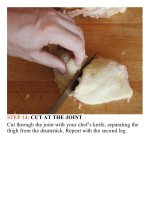The food lab better home cooking through science ( PDFDrive ) 790
Bạn đang xem bản rút gọn của tài liệu. Xem và tải ngay bản đầy đủ của tài liệu tại đây (122.72 KB, 2 trang )
That’sright.Weeatmorethan100poundsofchickenper
year each, but, we eat only 0.8 pound lamb per year, and
the amount is getting smaller every year—in the 1970s, it
wasalarger,butstillwoefullytiny,3poundsperyear.Not
only that, but the vast majority of Americans don’t eat a
single bite of lamb all year. Most of this per capita
consumption comes from minority communities—Greek,
Muslim,Indian—whoeatatonofit,bringinguptheoverall
average.
Even more distressing is the fact that lamb is what
economists call an “inferior good,” which means that its
demand is inversely proportional to average consumer
income: when people have money to spend, they’d rather
spend it on beef and chicken breasts. A 2001 study from
KennesawStateUniversityinGeorgiafoundthatforevery1
percent increase in consumer income, there was a
corresponding 0.54 percent decrease in lamb consumption.
It’sanodddichotomy,becausewhileinmanycommunities,
lamb is seen as the “cheap” meat—the meat to buy when
you can’t afford beef—in high-end food and fancy
supermarket circles, it’s often far more expensive, and
desirable,thanbeef.
I’m with the latter camp. I can think of precious few
situations when I’d rather have a steak than a fatty, musky
lambchop.OrwhenI’dratherhaveapotroastthanarich,
slightly funky braised lamb shank. And when it comes to
holiday roasts, prime rib may be the king of the table, but
roastedlegoflambishiswilder,morefuncousin.
Lambmarketerswhohavelongknownofthetroublewith
selling their product to consumers reluctant to leave the
safetyoftheirbelovedchickenandbeef,haverespondedby
carefullybreedingandraisinglambthatismoresuitablefor
theAmerican palate, as well as selling it in forms that are
increasinglyeasiertocook.Indeed,ifyouhaven’tattempted









